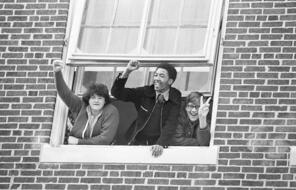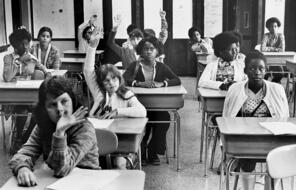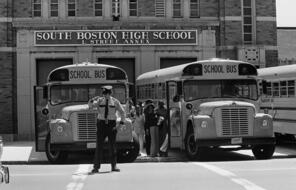A Latina Mother Responds to Conditions at School
At a Glance
Subject
- Civics & Citizenship
- Social Studies
- Democracy & Civic Engagement
- Human & Civil Rights
- Racism
In her essay “‘We Took ’Em On’: The Latino Movement for Educational Justice in Boston, 1965–1980,” historian Tatiana Cruz describes what Carmen Pola, a Latina mother and community organizer, saw when she visited the school her daughters attended in Boston:
In 1972, Carmen Pola was horrified when she walked into her daughters’ classroom at the Farragut Elementary School in Boston. They were a year apart in the fourth and fifth grades, respectively, but had been placed in the same crowded classroom with over forty Latino children. Amid the chaos of students throwing things and cursing in Spanish stood a young white teacher who appeared helpless and could not settle them down. In fact, the teacher could not communicate with her students at all since she spoke only English and the children were all recent migrants and only spoke Spanish. Pola was a migrant herself from Puerto Rico and had lived in Oakland, California, for over fifteen years. Her daughters were struggling to adjust to a new life in the poor Mission Hill neighborhood of Boston, having grown accustomed to a comfortable middle-class lifestyle and private school education in an Oakland suburb. They had lived in Boston for less than six months when Pola arrived at Farragut to check on her daughters’ progress, yet she quickly realized this was not a space of learning; instead the classroom functioned more like a childcare center.
Pola was an experienced community organizer who was known for her assertive attitude and ability to take charge of a situation. Appalled by the lack of order and the ineffectiveness of the teacher, she slammed her hand down on a desk and shouted, “¡Cállensen!” which silenced the students. After minutes in that classroom, Pola decided to remove her children from Boston Public Schools. She thanked the teacher and marched out of the school straight to a Catholic church, where she explained her story to a nun who immediately enrolled her girls in Mission Grammar, the adjoining parochial school.
Although Pola had defiantly chosen to withdraw her children from Farragut that day, she did not abandon her commitment to public education. There were less than five Latino families at Mission Grammar, and Pola knew that private and parochial schools were not an option for most Latinos who lived in poverty. The majority of Latinos, like African Americans, struggled to navigate Boston’s segregated, inequitable school system during the 1960s and 1970s. Latino children confronted many obstacles, including language barriers, inadequate teaching and counseling, dilapidated buildings and overcrowded classrooms, limited curriculums, and severe shortages of materials. Pola explained, “Our children were not getting the same treatment, the same resources, the nice books, [or] the nice buildings as other children were.” They also endured hostility and violence from their peers and dropped out at alarmingly high rates. 1
- 1Tatiana M. F. Cruz, “‘We Took ’Em On’: The Latino Movement for Educational Justice in Boston, 1965–1980,” Journal of Urban History 43, issue 2 (2017): 235–55.













